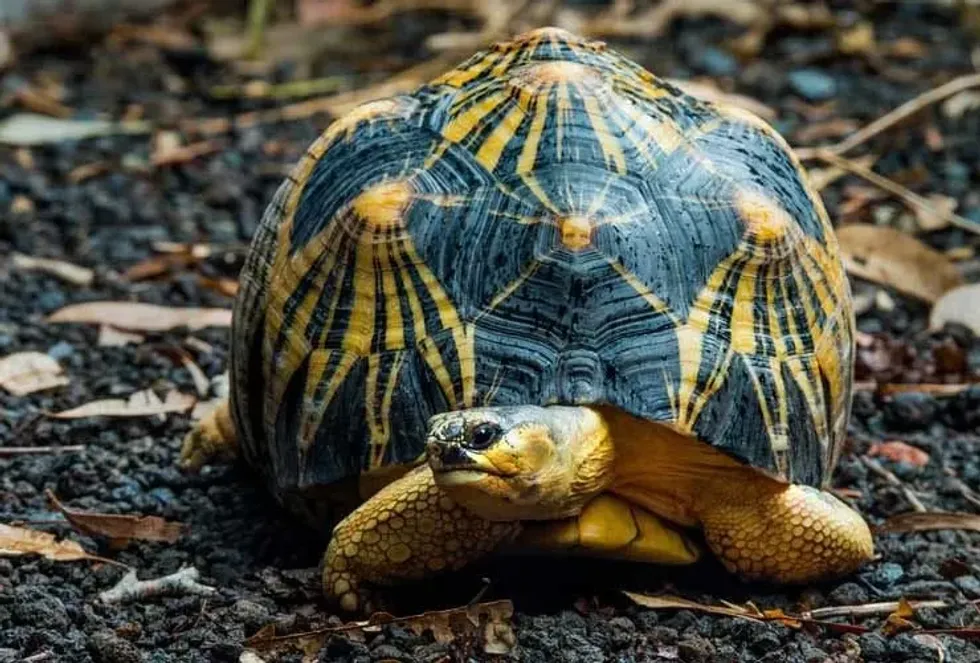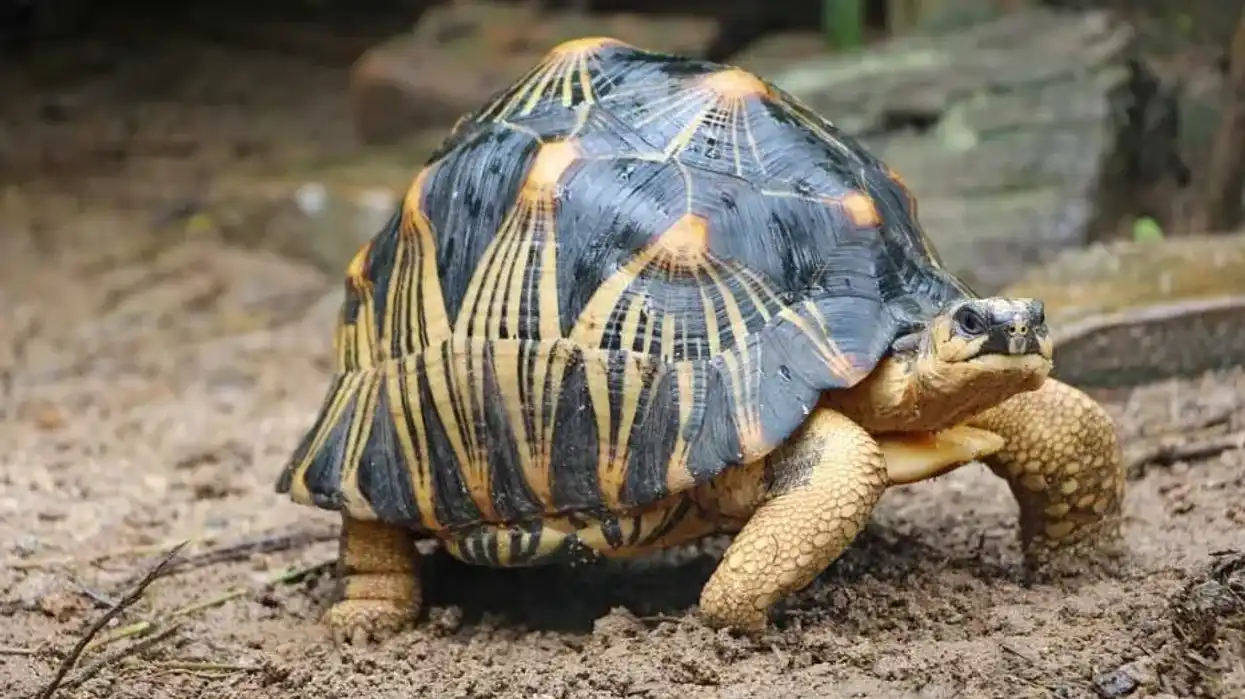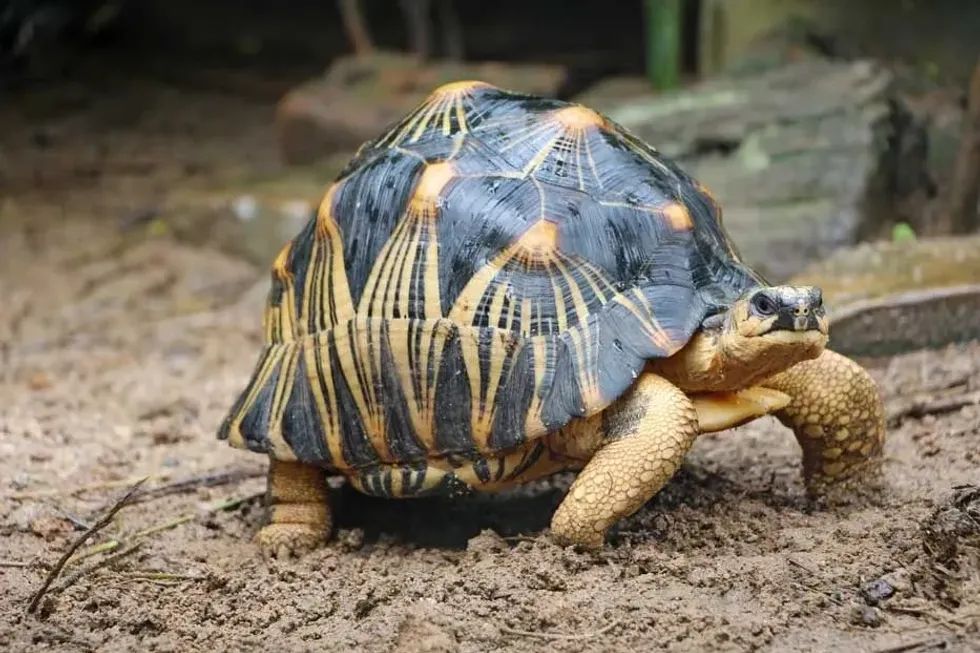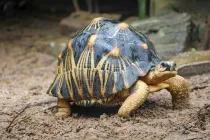Fun Radiated Tortoise Facts For Kids

A fairly large tortoise species, the radiated tortoise is predominantly seen on the island of Madagascar and now introduced to the nearby islands as well. The complex and striking patterns and markings on its shell differentiates these radiated tortoises from other species found in similar environments.
For example, the Indian star tortoise also has fairly similar star patterned markings but not the same as the yellow coloration of the radiated tortoise's complex patterns. Known locally as ‘Sokake’ in Madagascar, the radiated tortoise is currently categorized as a Critically Endangered species in the wild.
These spectacular animals are widely believed to be the most stunningly beautiful among all tortoise species.
Because of this, there is a lot of demand for these creatures to kept as illegal pets. Over the years, they have also been extensively hunted for food, too.
Once you have read this article, you'll have knowledge about the critically endangered Madagascar radiated tortoise, radiated tortoise adaptations, radiated tortoise conservation, radiated tortoise population, radiated tortoise diet, radiated tortoise size, radiated tortoise care, radiated tortoise shell, radiated tortoise's domed shell.
You may also check out our animal fact files on leatherback sea turtle and aldabra giant tortoise.
Radiated Tortoise Interesting Facts
What type of animal is a radiated tortoise?
The radiated tortoise (radiated tortoise scientific name, Astrochelys radiata) is a species of large tortoises.
What class of animal does a radiated tortoise belong to?
The radiated tortoise is a reptile.
How many radiated tortoises are there in the world?
There are around 6.3 million radiated tortoises in the world.
Where does a radiated tortoise live?
Radiated tortoises live in dry, spiny forests and places with limited, irregular rainfall.
What is a radiated tortoise's habitat?
The radiated tortoise prefers bushes, grasslands and woodlands. Almost the entirety of the population, at one point, was located within a span of 10000 square kilometers in Madagascar.
Who do radiated tortoises live with?
Radiated tortoises are generally solitary animals. But during the breeding season they can be seen grazing in a group on vegetation in the area.
How long does a radiated tortoise live?
These tortoises have a long like from 30-80 years. The radiated tortoise with the longest lifespan recorded was a radiated tortoise called Tu'i Malila who lived to an age of 188 years.
How do they reproduce?
Radiated Tortoises usually begin mating when they are around 12 in (31 cm) or around half their adult size. They initiate the procedure with the male tortoise bobbing his head up and down in order to court his female tortoise.
They may lift the female tortoise using the edge of his shell for smelling the female's hind legs. Reproduction itself is quite dangerous with the possibility of the female’s domed shell being broken. Hissing and grunting by the male tortoise is quite common.
Now to promote numbers, captive breeding of these reptiles is encouraged. Captive breeding programs has shown great promise in the increase in numbers of these animals.
What is their conservation status?
These magnificent creatures had endured extensive habitat loss and poaching for years. This has resulted in the population of radiated tortoises being reduced by almost 47% in the last 11 years alone. But with controlled captive breeding programs undertaken throughout the world have been fairly successful.
Radiated Tortoise Fun Facts
What do radiated tortoises look like?
Radiated tortoises have a standard tortoise body shape, consisting of the high domed carapace. Radiated tortoises also have a blunt head and big, elephantine feet.
The carapace or the shell of the radiated tortoise is incredibly marked with yellow lines. These yellow lines radiate from the black patch on top of the carapace. Radiated tortoises get their name because of this pattern.
When compared with females, male radiated tortoises are usually a little bigger. Males can grow up to 40 cm and the females can grow up to 25–30 cm. Males definitely have longer tails. The notches under their tails are also significantly more noticeable.

How cute are they?
The radiated tortoises are simply mesmerizing to look at. These adorable tortoises even dance in the rain.
When the rain falls on them they try to shake off the water from their back by doing a little dance. The juvenile or hatchlings tortoises are a sight to behold. While the adults have yellow patterns on their carapace, the patterns on the hatchlings or juveniles are a white or off-white shade.
Their cuteness is one of the main reasons why there is a lot of illegal pet trade among these species. Up until a few decades ago there were no restrictions on the import and export of these magnificent beings. During that period, hundreds of thousands of radiated tortoises were purchased all over the globe to be kept as pets.
How do they communicate?
For all modes of communication radiated tortoises use hisses and grunts. But under the threat of predators the tortoises can give out a shriek which is loud or high pitched. The purpose of the shriek is to startle the predator.
How big is a radiated tortoise?
The male radiated tortoise can grow up to 40 cm which is five times as big as the smallest of the tortoise family, the speckled tortoise. Radiated tortoises can also weigh up to 35 lb (16 kg).
How fast can a radiated tortoise move?
Radiated tortoises, like most tortoises, are quite slow when it comes to movement. Adult tortoises can walk at 0.3 miles per second. But when threatened they do have the propensity to lunge.
How much does a radiated tortoise weigh?
Adult radiated tortoises can weigh anywhere between 2.2-16kg (4.9-35 lb). As compared to adults, the Juveniles or hatchlings are tiny. Most of this weight is carried on their shell or carapace.
What are their male and female names of the species?
Radiated tortoises are referred to by their scientific binomial name which is Astrochelys radiata. While referring to individual genders, they are just called male and female.
What would you call a baby radiated tortoise?
Baby radiated tortoises are called hatchlings or juveniles.
What do they eat?
Being primarily vegetarian or herbivorous, the Astrochelys radiata mainly eats plant matter. In order to healthily thrive, radiated tortoises need a low protein and high fibre diet.
So, leafy vegetables and greens, herbs and grasses make up the majority of their diet. They are also know to eat berries, pears, and fruits. Radiated tortoises prefer thorn forests woodlands and dry regions of brush of extreme southern Madagascar and southwestern Madagascar.
It is supposed that their favorite food in the wild is the opuntia, which is a species of cactus. They are also known to graze regularly on same spot. They are habitual grazer. Grasslands closely trimmed they seem to prefer. An area closely trimmed of grass in their habitat could mean, tortoises are around there somewhere.
Opuntia cactus is rich is most nutrients and moisture and are found in plenty in the extreme southern and southwestern region of Madagascar. But it is a very invasive species of cactus which quickly replaces other varieties of vegetation.
It has now become a problem for conservationists because radiated tortoises don’t eat other vegetation and thus keeping the vegetation intact if Opuntia Cactus is around. This has caused some deformities and deficiencies in some tortoises.
The deformities are mostly limited to the shell or the high domed carapace because of low calcium content in Opuntia Cactus. Low fiber content in their food and low fiber content in the area of grazing can result in them getting some deformities.
Are they dangerous?
Radiated tortoises generally tend to be peaceful but will display aggressive behavior towards individuals that they perceive as a threat. During breeding season, as with all animals, rival males will engage in aggressive behavior and try to roll the other over onto their backs.
It is very difficult for a tortoise to get back on their feet once they are rolled over. In this condition they become easy prey for predators such as large birds and snakes.
Would they make a good pet?
Radiated tortoises make excellent pets. Radiated tortoises are spectacular to look at and are neither too small nor too large. They are also docile in nature.
Combine all this and they appear as an ideal pet. It is also a bonus that they cannot run away at will. They also have a long life span. A typical pet tortoise will live for about 60 years.
They are also not at all fussy about their food. Since most of their diet is anyway comprised of leafy greens, they are very easy to maintain as well. They do need a lot of sunlight and open spaces though.
Did you know...
Radiated Tortoises are categorized as herbivores. But if nutrition supplements are required, they have been known to eat small animals, too.
To protect themselves from predators they will pull their limbs and head into their shells and stay there until the threat has passed.
Tu'i Malila, the oldest recorded radiated tortoise, was actually gifted to the Royal family of Tonga by Captain James Cook in 1777. She went passed away in 1966 making her the oldest radiated tortoise ever.
Radiated Tortoises are generally active during the day and sleep during the night. They are early risers and start foraging immediately.
During the monsoon or wet season, their body stores immense quantities of water to prepare itself for the extended dry season.
Radiated tortoise’s ability to store water and to be able to manage with very little food means they can survive under the harshest of conditions.
Incubation period for the radiated tortoise eggs is quite long. It generally lasts for about 5-8 months. The hatchlings get their carapace soon after hatching.
The female radiated tortoise will lay anywhere between 3-12 nearly spherical eggs and store them in burrows. Females lay their eggs and leave.
Neither the male nor female visit the burrows during this incubation period.
Radiated tortoises have been found to be both polygynous (multiple females to one male) and polyandrous (multiple males to one female).
Under duress, a radiated tortoise will pull their legs feet and head into their shell and let out a high pitched cry. This can go on for an hour or so.
Against popular belief, the radiated tortoise, and for that matter all tortoises, have millions of nerve ending on their shells. They can feel and differentiate objects based on touch.
Can you own a radiated tortoise?
It is legal to own a radiated tortoise in the US but it is illegal to sell or trade the reptile. But we do see a lot of these reptiles as pets in the North American continent.
Why is the radiated tortoise endangered?
Radiated tortoises are Critically Endangered. They have long been hunted for their meat by humans. The shells are also sold on the black market for making jewellery.
Apart from this selling these magnificent reptiles in pet trade is also one of the main causes of decline in their numbers. But the foremost reason for their decline is the loss of habitat due to encroachment by humans.
According to some surveys conducted by WWF, around 46,000-60,000 radiated tortoises are illegally harvested every year for bush meat and for pet trade. These are just the official figures. The actual figures might be more.
Here at Kidadl, we have carefully created lots of interesting family-friendly animal facts for everyone to discover! Learn more about some other reptiles including olive ridley sea turtle, or bog turtle.
You can even occupy yourself at home by drawing one on our Radiated tortoise coloring pages.
We Want Your Photos!
More for You
Bachelors in Business Administration

Aashita DhingraBachelors in Business Administration
Based in Lucknow, India, Aashita is a skilled content creator with experience crafting study guides for high school-aged kids. Her education includes a degree in Business Administration from St. Mary's Convent Inter College, which she leverages to bring a unique perspective to her work. Aashita's passion for writing and education is evident in her ability to craft engaging content.
Bachelor of Law

Abdulqudus MojeedBachelor of Law
A versatile professional with a passion for creative writing and technology. Abdulqudus is currently pursuing his Bachelor of Law from the University of Lagos and has experience as a tutor, intern assistant, and volunteer. He possesses strong organizational skills and is a detail-oriented person.
Disclaimer
1) Kidadl is independent and to make our service free to you the reader we are supported by advertising. We hope you love our recommendations for products and services! What we suggest is selected independently by the Kidadl team. If you purchase using the Buy Now button we may earn a small commission. This does not influence our choices. Prices are correct and items are available at the time the article was published but we cannot guarantee that on the time of reading. Please note that Kidadl is a participant in the Amazon Services LLC Associates Program, an affiliate advertising program designed to provide a means for sites to earn advertising fees by advertising and linking to Amazon. We also link to other websites, but are not responsible for their content.
2) At Kidadl, we strive to recommend the very best activities and events. We will always aim to give you accurate information at the date of publication - however, information does change, so it’s important you do your own research, double-check and make the decision that is right for your family. We recognise that not all activities and ideas are appropriate for all children and families or in all circumstances. Our recommended activities are based on age but these are a guide. We recommend that these ideas are used as inspiration, that ideas are undertaken with appropriate adult supervision, and that each adult uses their own discretion and knowledge of their children to consider the safety and suitability. Kidadl cannot accept liability for the execution of these ideas, and parental supervision is advised at all times, as safety is paramount. Anyone using the information provided by Kidadl does so at their own risk and we can not accept liability if things go wrong.
3) Because we are an educational resource, we have quotes and facts about a range of historical and modern figures. We do not endorse the actions of or rhetoric of all the people included in these collections, but we think they are important for growing minds to learn about under the guidance of parents or guardians.







